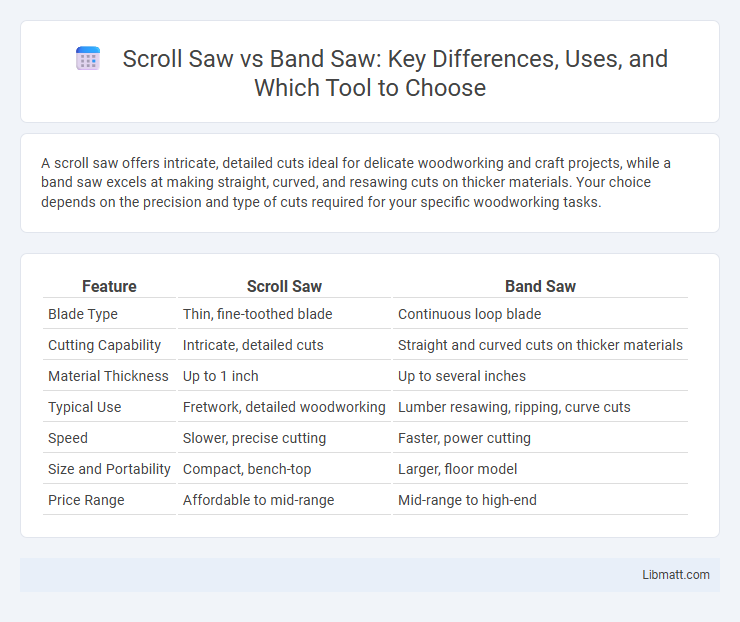A scroll saw offers intricate, detailed cuts ideal for delicate woodworking and craft projects, while a band saw excels at making straight, curved, and resawing cuts on thicker materials. Your choice depends on the precision and type of cuts required for your specific woodworking tasks.
Table of Comparison
| Feature | Scroll Saw | Band Saw |
|---|---|---|
| Blade Type | Thin, fine-toothed blade | Continuous loop blade |
| Cutting Capability | Intricate, detailed cuts | Straight and curved cuts on thicker materials |
| Material Thickness | Up to 1 inch | Up to several inches |
| Typical Use | Fretwork, detailed woodworking | Lumber resawing, ripping, curve cuts |
| Speed | Slower, precise cutting | Faster, power cutting |
| Size and Portability | Compact, bench-top | Larger, floor model |
| Price Range | Affordable to mid-range | Mid-range to high-end |
Introduction to Scroll Saws and Band Saws
Scroll saws feature a fine, reciprocating blade ideal for intricate cuts and detailed woodworking projects, offering precision and control. Band saws use a continuous loop blade to efficiently cut curves and straight lines through thicker materials and larger workpieces, providing versatility and power. Both tools serve essential roles in woodworking, tailored to different cutting requirements and material thicknesses.
Key Differences Between Scroll Saws and Band Saws
Scroll saws feature a fine, narrow blade that moves up and down, allowing for intricate and detailed cuts ideal for delicate woodworking and craft projects. Band saws use a continuous loop blade that moves on two wheels, enabling them to make thicker, straight, or curved cuts efficiently in larger pieces of wood or metal. Scroll saws excel in precision and detail, whereas band saws are better suited for heavy-duty cutting tasks and resawing.
Design and Functionality Comparison
Scroll saws feature a fine, narrow blade that moves up and down, allowing for intricate and detailed cuts ideal for woodworking and craft projects. Band saws utilize a continuous loop blade running on two wheels, enabling the cutting of larger, thicker materials with smoother curves and straight lines. Your choice depends on the complexity of the design and the thickness of the material you plan to work with.
Types of Projects Suitable for Each Saw
Scroll saws excel in intricate woodworking projects requiring precision, such as detailed patterns, puzzles, and delicate inlays. Band saws are better suited for cutting larger materials, resawing lumber, and making curved or straight cuts in thicker wood. Your choice depends on project complexity and material size, with scroll saws ideal for fine craftsmanship and band saws for more robust, versatile cutting needs.
Precision and Cutting Accuracy
A scroll saw offers superior precision and intricate cutting accuracy, ideal for detailed patterns and fine woodworking projects. In contrast, a band saw provides more power and smoother straight or curved cuts but lacks the delicate control required for intricate designs. Your choice depends on whether precision for detailed work or versatility for larger cuts is the priority.
Blade Types and Cutting Capacity
Scroll saws utilize fine, narrow blades ideal for intricate, detailed cuts in thin materials up to 2 inches thick, primarily wood or soft metals. Band saws employ continuous loop blades with various tooth configurations suited for cutting thicker materials, ranging from wood to metal, with cutting capacities typically exceeding 6 inches in depth. Blade selection in band saws focuses on material type and thickness, while scroll saw blades prioritize precision and intricacy.
Ease of Use and Safety Features
A scroll saw offers superior ease of use for intricate cuts due to its lightweight design and precise blade control, making it ideal for beginners and detailed woodworking projects. Band saws, while more powerful and capable of cutting thicker materials, require greater skill and attention to safety features such as blade guards and emergency stops to prevent accidents. Evaluating your skill level and project needs helps determine which saw provides the optimal balance of usability and safety for Your workshop.
Cost and Maintenance Considerations
Scroll saws generally have a lower upfront cost and require less maintenance due to their simpler design and smaller, lightweight blades. Band saws, while often more expensive initially, demand more frequent blade replacements and regular blade tension adjustments to maintain precision. Your choice depends on budget constraints and willingness to perform routine maintenance for long-term performance.
Pros and Cons of Scroll Saws
Scroll saws excel in intricate, detailed cuts with precision, making them ideal for delicate woodworking projects and patterns. Their compact size and ease of blade changes enhance maneuverability, but they are less effective for cutting thick or large pieces compared to band saws. Limitations include slower cutting speeds and reduced power, which can hinder performance on tougher materials.
Pros and Cons of Band Saws
Band saws offer precise, straight cuts and are capable of resawing thick wood sheets, making them ideal for heavy-duty woodworking projects. However, their larger blade size limits intricate curves and detailed cuts compared to scroll saws, which excel in fine, delicate work. The higher cost and larger footprint of band saws can be a drawback for hobbyists with limited space or budget.
Scroll saw vs band saw Infographic

 libmatt.com
libmatt.com